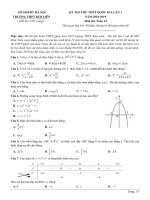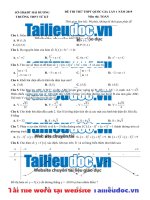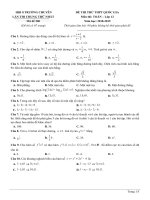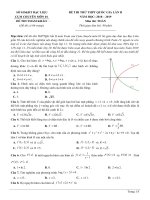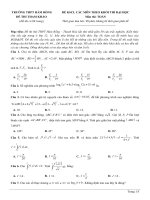So gd va dt tinh bac lieu lan 1 file word co ma tran loi giai chi tiet www hoctai vn
Bạn đang xem bản rút gọn của tài liệu. Xem và tải ngay bản đầy đủ của tài liệu tại đây (198.5 KB, 6 trang )
SỞ GD&ĐT TỈNH BẠC LIÊU
ĐỀ THI THỬ THPTQG NĂM 2019 LẦN 1
(Đề thi có 05 trang)
Môn thi: TIẾNG ANH (Mã đề 209)
Thời gian làm bài: 60 phút, không kể thời gian phát đề
Họ, tên thí sinh: .......................................................................
Số báo danh: ............................................................................
Mark the letter A, B, C, or D on your answer sheet to indicate the word whose underlined part differs from
the other three in pronunciation in each of the following questions.
Question 1. A. laughs
B. machines C. parents
D. photographs
Question 2. A. arrived
B. mended
C. invited
D. planted
Mark the letter A, B, C, or D on your answer sheet to indicate the word that differs from the other three in
the position of primary stress in each of the following questions.
Question 3. A. attitude
B. attention C. determine D. atomic
Question 4. A. chemistry B. satisfy
C. buffalo
D. tobacco
Mark the letter A, B, C, or D on your answer sheet to indicate the undelined part that needs correction in
each of the following questions.
Question 5. The founding of the Radium Institute in 1914 made her dream coming true.
A
B
C
D
Question 6. Let’s to get up early to go for a walk before breakfast.
A
B C
D
Question 7. My manager wanted to know that whether I was taking much money with me to France.
A
B
C
D
Mark the letter A, B, C, or D on your answer sheet to indicate the correct answer to each of the following
questions.
Question 8. Rodney ______ for the company for very long before he was promoted.
A. didn’t used to work
B. didn’t work
C. hasn’t been working
D. hadn’t been working
Question 9. John said he ______ to visit me the day after.
A. had come
B. will come
C. came
D. would come
Question 10. John ______ taking the money, but nobody believed him.
A. denied
B. apologized
C. refused
D. warned
Question 11. The director deputy ______ the responsibility for organizing meetings and conferences.
A. makes
B. becomes
C. takes
D. gets
Question 12. He expected ______ for an Oscar, but he wasn’t.
A. nominating
B. to nominate
C. to be nominated
D. being nominated
Question 13. Some candidates failed the oral exam because thay didn’t have enough ______ .
A. confidence
B. confidentially
C. confident
D. confidential
Question 14. It was on March 19th, 1876 ______ the first telephone call was made.
A. that
B. which
C. then
D. where
Question 15. You should use this cream ______ the sun from damaging your skin.
A. for prevent
B. to prevent
C. to preventing
D. preventing
Question 16. My brother ______ while he ______ his bicycle and hurt himself.
A. had fallen / rode
B. was falling / rode
C. fell / was riding
D. had fallen / was riding
Question 17. The viewers ______ to his suggestion with a big clap.
A. response
B. responded
C. responsive
D. respondent
Question 18. Mr. Kane finds it hard to ______ friendly relations with his thoughtless neighbors.
A. confide
B. maintain
C. sacrifice
D. precede
Question 19. Nothing unusual happened, _______?
A. did it
B. didn’t it
C. did they
D. didn’t they
Mark the letter A, B, C, or D on your answer sheet to indicate the most suitable response to complete each
of the following exchanges.
Question 20. Anne: “Do you think we’ll have good weather?”
Susan: “ ____________.”
A. No, I won’t
B. No, I hope
C. Yes, I hope so
D. Yes, I’m afraid so
Question 21. Anna: “I think we should recycle these bags. It will help protect the environment.”
John: “ __________________. ”
A. It’s rubbish. We shouldn’t use it.
B. I can’t agree with you more
C. Never mind
D. You can say that again
Mark the letter A, B, C, or D on your answer sheet to indicate the word(s) CLOSEST in meaning to the
underlined word(s) in each of the following questions.
Question 22. We can use either verbal or non-verbal forms of communication.
A. posture
B. Speech
C. facial expressions
D. gesture
Question 23. In my attempt to win a place at university, I am under a lot of pressure.
A. strong influence
B. difficulties
C. allowance
D. force
Mark the letter A, B, C, or D on your answer sheet to indicate the word(s) OPPOSITE in meaning to the
underlined word(s) in each of the following questions.
Question 24. In Western culture, it is polite to maintain eye contact during conversation.
A. informal
B. insecure
C. discourteous
D. irresponsible
Question 25. There have been significant changes in women’s lives since the women’s liberation
movement.
A. controlled
B. political
C. disagreeable
D. unimportant
Mark the letter A, B, C, or D on your answer sheet to indicate the sentence that is closest in meaning to
each of the following questions.
Question 26. “I am sorry, Jean. I broke your bicycle”, said John.
A. John apologized to Jean having broken her bike.
B. John apologized to Jean for having broken her bike.
C. John apologized Jean for breaking his bike.
D. John apologized Jean about having broken her bike.
Question 27. “Shall I carry the suitcase for you, Mary?”, said John.
A.John offered Mary to carry the suitcase for Mary.
B. John offered to carry the suitcase for Mary.
C. John offered carrying the suitcase for Mary.
D. John offered Mary if he should carry the suitcase for her.
Question 28. It is said that he broke the world record.
A. He is said to have broken the world record.
B. People said that he broke the world record.
C. People were said that world record has been broken by him.
D. He is said that he had broken world record.
Mark the letter A, B, C, or D on your answer sheet to indicate the sentence that best combines each pair of
sentences in the following questions.
Question 29. A waitress served us. She was very impolite and impatient.
A. A waitress served us was very impolite and impatient.
B. A waitress to serve us was very impolite and impatient.
C. A waitress to be served us was very impolite and impatient.
D. A waitress serving us was very impolite and impatient.
Question 30. Mary lost the ticket. She didn’t go to the concert.
A. Were Mary not to lose the ticket, she would have gone to the concert.
B. If Mary hadn’t lost the ticket, she would go to the concert.
C. Unless Mary had lost the ticket, she would have gone to the concert.
D. Had Mary not lost the ticket, she would go to the concert.
Read the following passage and mark the letter A, B, C or D on your answer sheet to indicate the correct
word for each of the blanks from 31 to 35.
In Japan, politeness and good manners are very important and business meetings are very formal.
Business cards are also important and they (31) ________ these at the beginning of a meeting. They always
look at them carefully, so you should do the same as they might think you're rude if you don't. A lot of
communication is non-verbal. They are very good listeners and may ask a lot of questions to (32)_____ they
understand everything.
In a conversation they wait longer before they reply than westerners do, so it's important (33)_______
speak in those long pauses but to wait for their reply. In their culture it's rude to ask direct questions or to say
'No' or 'I disagree'. In business it takes a long time to (34)_______ a decision because they have to ask
everyone in the company. When they say 'Yes' it may mean 'I understand', not 'I agree', and when they smile
it might be because they don't know (35)_______ to say.
Question 31. A. barter
B. change
C. exchange
D. purchase
Question 32. A. find
B. identify
C. check
D. notice
Question 33. A. not
B. not to
C. don’t
D. to not
Question 34. A. make
B. take
C. get
D. gain
Question 35. A. That
B. who
C. what
D. when
Read the following passage and mark the letter A, B, C or D on your answer sheet to indicate the correct
answer to each of the questions from 36 to 42.
Although speech is the most advanced form of communication, there are many ways of communicating
without using speech. Signals, signs, symbols and gestures may be found in every known culture. The basic
function of a signal is to impinge upon the environment in such a way that it attracts attention, as, for
example, the dots and dashes of telegraph circuit. Coded to refer to speech, the potential for communication
is very great. Less adaptable to the codification of words, signs also contain meaning in and of themselves. A
stop sign or a barber pole conveys meaning quickly and conveniently.
Symbols are more difficult to describe than either signals or signs because of their intricate relationship
with the receiver's cultural perceptions. In some cultures, applauding in a theater provides performers with an
auditory symbol of approval. Gestures such as waving and handshaking also communicate certain cultural
messages.
Although signals, signs, symbols and gestures are very useful, they do have a major disadvantage.
They usually do not allow ideas to be shared without the sender being directly adjacent to the receiver.
Without an exchange of ideas, interaction come to a halt. As a result, means of communication intended to be
used for long distances and extended periods must be based upon speech. To radio, television and the
telephone, one must add fax, paging systems, electronic mail, and the Internet, and no doubts but that there
are more means of communication on the horizon.
Question 36. Which of the following would be the best title for the passage?
A. Signs and signals
B. Gestures
C. Communication
D. Speech
Question 37. What does the author say about speech?
A. It is necessary for communication to occur.
B. It is the most advanced form of communication.
C. It is dependent upon the advances made by inventors.
D. It is the only true form of communication.
Question 38. The phrase “impinge upon” in paragraph 1 is closest in meaning to _______.
A. prohibit
B. improve
C. vary
D. intrude
Question 39. The word “it” in paragraph refers to _______.
A. signal
B. Function
C. way
D. environment
Question 40. Applauding was cited as an example of _______.
A. a sign
B. a gesture
C. a signal
D. a symbol
Question 41. Why were the telephone, radio, and television invented?
A. Because people wanted to communicate across long distances.
B. Because people wanted new forms of communication.
C. Because people were unable to understand signs, signals, and symbols.
D. Because people believed that signs, signals, and symbols were obsolete.
Question 42. It may be concluded from this passage that _______.
A. symbols are very easy to define and interrupt
B. only some cultures have signs, signals, and symbols
C. waving and handshaking are not related to culture
D. signs, signals, symbols, and gestures are forms of communication.
Read the following passage and mark the letter A, B, C or D on your answer sheet to indicate the correct
answer to each of the questions from 43 to 50.
An air pollutant is defined as a compound added directly or indirectly by humans to the atmosphere in
such quantities as to affect humans, animals, vegetation, or materials adversely. Air pollution requires a very
flexible definition that permits continuous changes. When the first air pollution laws were established in
England in the fourteenth century, air pollutants were limited to compounds that could be seen or smelled - a
far cry from the extensive list of harmful substances known today. As technology has developed and
knowledge of the health aspects of various chemicals has increased, the list of air pollutants has lengthened.
In the future, even water vapor might be considered an air pollutant under certain conditions.
Many of more important air pollutants, such as sulfur oxides, carbon monoxides and nitrogen oxides
are found in nature. As the Earth developed, the concentration of these pollutants was altered by various
chemical reactions; they became components in biogeochemical cycles. These serve as an air purification
scheme by allowing the compounds to move from the air to the water or soil. On a global basis, nature's
output of these compounds dwarfs that resulting from human activities.
However, human production usually occurs in a localized area, such as a city. In such a region, human
output may be dominant and may temporarily overload the natural purification scheme of the cycles. The
result is an concentration of noxious chemicals in the air. The concentrations at which the adverse effects
appear will be greater than the concentrations that the pollutants would have in the absence of human
activities. The actual concentration need not be large for a substance to be a pollutant; in fact, the numerical
value tells us little until we know how much of an increase this represents over the concentration that would
occur naturally in the area. For example, sulfur dioxide has detectable health effects at 0. 08 parts per million
(ppm), which is about 400 times its natural level. Carbon monoxide, however has a natural level of 0. 1 ppm
and is not usually a pollutant until its level reaches about 15 ppm.
Question 43. What does the passage mainly dicuss?
A. What constitutes an air pollutant.
B. How much harm air pollutants can cause.
C. The economic impact of air pollution.
D. The effects of compounds added to the atmosphere
Question 44. The word “adversely” in the first paragraph is closest in meaning to ______.
A. considerably
B. quickly
C. admittedly
D. negatively
Question 45. It can be inferred from the first paragraph that ______.
A. the definition of air pollution will continue to change.
B. Most air pollutants today can be seen or smelled.
C. a substance becomes an air pollutant only in cities.
D. water vapor is an air pollutant in localized areas.
Question 46. The word “these” in the second paragraph is closest in meaning to _____.
A. the compounds moved to the water or soil
B. the pollutants from the developing Earth
C. the various chemical reactions
D. the components in biogeochemical cycles
Question 47. For which of the following reasons can natural pollutants play an important role in controlling
air pollution?
A. They're less harmful to living beings than other pollutants.
B. They function as part of a purification process.
C.They occur in greater quantities than other pollutants.
D. They have existed since the Earth developed.
Question 48. According to the passage, human- generated air pollution in localized regions ______.
A. will react harmfully with natural pollutants.
B. can overwhelm the natural system removing pollutants.
C. will damage area outside of the localized regions.
D. can be dwarfed by nature's output of pollutants.
Question 49. The word “localized” in the third paragraph is closest in meaning to .
A. surrounded
B. encircled
C. specified
D. circled
Question 50. According to the passage, the numerical value of the concentration level of a substance is only
useful if .
A. it can be calculated quickly
B. it is in a localized area
C. the natural level is also known
D. the other substances in the area are known
----------- THE END ----------


